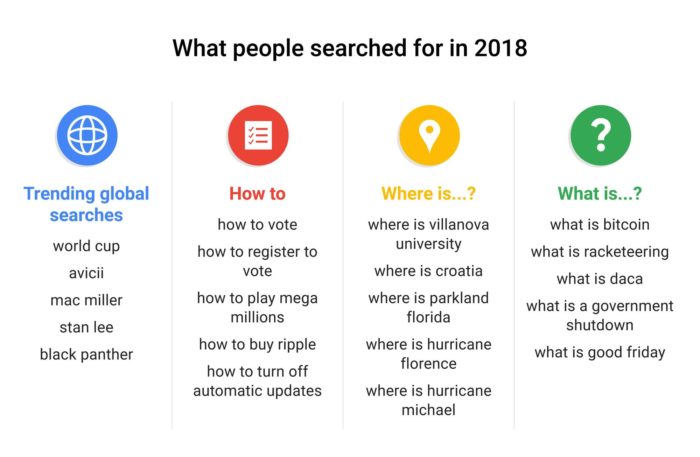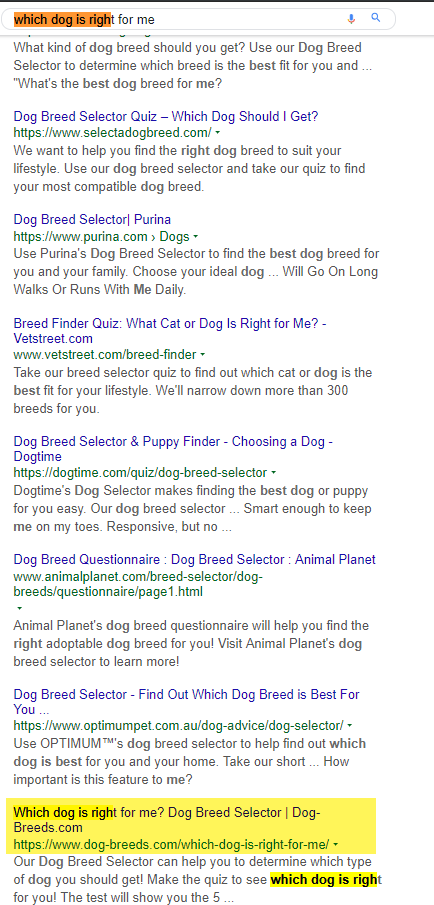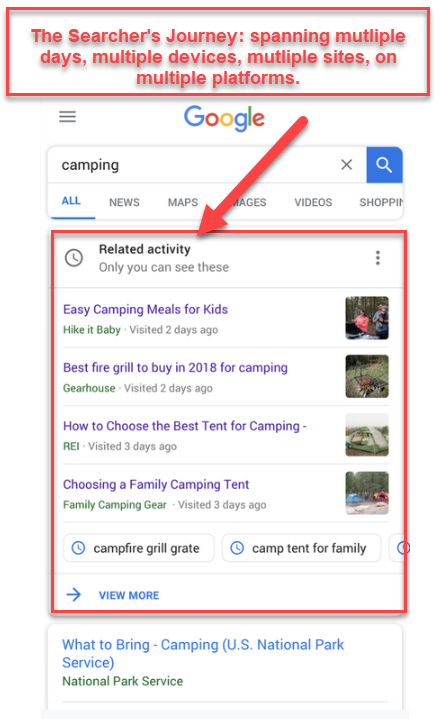Wondering what the key to SEO success will be today? Here it is: predict what your users want and give them a frictionless experience the way they want it where they want it.
That should be relatively easy to do, right?
After all, we’re chock full of more customer insights and data than ever before.
If only it were that easy.
Beyond the Data: Effective SEO Techniques
In 2018, we had to be more efficient at finding and acting quickly on data; knowing where to look, what to do with it, how to be empowered by it, and how NOT to get overwhelmed by it.
Today, we are required to go further: we must also predict and stay one step ahead of our research-hungry visitors and anticipate what they need and want.
The fun challenge with this is that it’s hard to maintain a firm grasp on our audience as new technology is constantly influencing our consumers.
To build our muscle in this area, let’s take a little journey and explore some of the top Google Search and digital marketing trends we’ve seen in the past year and how that should inform your SEO strategy and monthly activities. And if you’re looking for the most recent SEO trends, check out this post.
Search Queries and Intent: How to SEO
Once upon a time not so very long ago, search was stilted, mechanical, and very literal. Thus, the way we optimized to get ranked on Page 1 in the results required little more than going down a literal, tactical checklist and creatively applying ways to game the system.
Today, Google’s algorithm is uber sophisticated and takes in a multitude of factors to generate what it deems the best response to a user’s query. Hello Hummingbird and RankBrain! Remember, Google sees billions of queries every day, and 15% of queries they see are brand new. The only way they could serve useful, valuable answers is through their algorithmic approach.
While the shadier days of SEO are long gone (thank goodness), there are misperceptions and bad advice lingering which understandably contribute more confusion to an already complex discipline.
But onwards and upwards, right?
In 2018, Google Search turned 20 years old and we’re ushering in a new era of exciting changes that marketers need to keep up with. Google has said that in 2019, “the most successful marketers will begin to predict what people want.”
Several years ago, I wrote about first-hand observations I noticed in the industry and with my SEO client websites:
- Even when you had high rankings – clicks to organic website listings were decreasing
- Even when you did rank on Page 1 and got page visits – people were not reaching out or making immediate purchases like they used to
- The term “search engine” historically had been synonymous with Google; search engines today are any location where there is a search bar that you’re a consumer uses to type in a query and return results: Facebook, Twitter, Amazon, Quora, Pinterest, YouTube, Etsy.
- Investing in simple SEO tactics was no longer enough to move the needle
Evolving Marketing Efforts Requires Understanding The Modern Consumer
Same as last year, searchers are exhibiting many of the same traits and characteristics of how they search online. People today are:
- Research obsessed
- Impatient
- Empowered
- Time-starved and busy
- Researching purchases big, small, and everything in between
Along with these continually evolving demands, we must be religious about studying how our market uses their devices and what they’re used for.
Top Google Searches: Gaining Insight From Keyword Data
Take a look at Google’s chart of what people searched for in 2018:

Here are several stats Google has given us over the past few months revealing more insight into the intent behind the keyword data:
- Mobile searches with the qualifier “for me” have grown over 60%
- Mobile searches with the qualifier “should I” have grown over 65%
- Mobile searches for “brands like” and “stores like” have grown over 60% in the past two years
- Search interest in “open now” has grown 300% between 2015 and 2017
- Mobile searches for “best” have grown over 80% over the past two years
A few interesting notes: a term Google calls “advisory” searches is growing. Google’s example is that consumers aren’t just searching “best dog,” they’re searching “which dog is right for me.”
BTW – I dug a little more into the search count for “which dog is right for me,” and here are some interesting results:
- this query is returning around 1,000 searches per month
- the SERPS results bring back “dog breed selector” articles, quizzes, and questionnaire content formats which dominate Page 1. Even more interesting: note that only one result had the title tag matching “dog breed selector,” and it was in the very last place (Spot 10) on Page 1.

Here’s another tidbit marketers can use. When searchers search on “best” or “top” keywords, they’re not looking for the “best” from a general sense of the word. They’re looking for what’s best for how they need to use the product or service. For example, searchers are no longer relegated to “best shoes”…searches are for “best shoes for standing all day,” or “best walking shoes for women.” They’re not just searching for “best champagne”…they’re searching for “best champagne for mimosas.”
Homework: Look Through Search Console to Gain Insight
So what can you do to gain more insight from your keyword data?
Look for patterns.
- Do you notice searches that are increasingly detailed?
- Do you spot any queries coming in that are tailored to your audience?
- Do you have searches that begin with “best” or “top”?
- Do you show searches that indicate immediacy or urgency?
Now that we’ve looked at Search trends let’s take a look at staying in front of your audience in some of the newer areas.
A Refresher on Voice Search, Mobile Search, and Digital Assistants
What do voice search, mobile search, and digital assistants have in common?
They represent new trends and shifts in consumer search habits. If you’re a local business, ecommerce retailer, or media site, you especially need to be paying close attention.
It’s not new news that searches and questions are getting more vocal. comScore predicts that by 2020, 50 percent of all searches will be voice searches. Mary Meeker predicts that by 2020, there will be 200 billion voice search queries per month.
In my house, here are some of the regular commands and searches my children give to the various devices on any given day (especially around homework time):
- Alexa, what is the weather going to be today?
- Siri, when was George Washington born?
- Alexa, what’s 4×4?
- Siri, where should we order pizza from tonight?
- Alexa, play the poop song.

What exactly should marketers do to leverage voice search technology? Time will tell, but here’s what we know so far:
- Most of the commands for digital assistants are still around playing music or finding out the weather.
- In-depth searches are still being done on desktop and mobile
Moving Beyond the Search Bar to Voice
Asking Google has become commonplace. Now, it’s also turning to our home devices and digital assistants to entertain us, to get questions answered, and to get information.
Just ask my kids.
My 8-year old daughter informed me she didn’t need me phone calculator anymore because Alexa will tell her the answer to her math problems. In second grade, she is still learning to spell most words. However on our Chromebook, she doesn’t have to. She is a whiz at hitting the microphone on the search bar and speaking her query. And Google is getting darn good at interpreting her.

Women across the world are turning to Alexa to help solve problems. A day didn’t go by over these recent holidays when I didn’t see a humorous Alexa meme pop up:


Actionable takeaways for leveraging Voice Search:
- Continue to create, optimize, and publish valuable content on-site and off-site.
- Create content at the top of the funnel – well before your users are looking for your brand
- Aim for position zero
- Meet your users where they’re at – identify those micro moments that are important to your audience
- Get your Local SEO stuff together; most mobile searches focus on local needs
- Create conversational content focused on long-tail searches, which mimics how users are talking into their phone or device
- Get your technical SEO together; schema, page load, site structure, and metadata optimization will be even more important than they were before
Essentially, your foundational SEO basics have to be on point. (For more foundationa/101 information, see my post here that explains the difference between Voice Marketing vs Voice Search)
A Few Final Points On Search and SEO Trends For the Next Year
Your goal should be to be visible and dominate in all areas of your audience expertise or topical domain (no pun intended). As a senior SEO strategist at IBM quoted, “The entire search experience is our domain of expertise and control, and our goal isn’t to just drive traffic…it’s to ensure that we’ve optimized that search experience, whether web-based or app-based or [insert the next big technology]-based, to create the most efficient and engaging intersection of the user’s needs and the site’s offerings possible.”
As much as we want to drive all people to our organic website listings all the time, that’s not the reality.
A few actionable takeaways:
- What are the benefits/features that matter most today; not those that mattered 5 years ago? Highlight those. For example, not just “free shipping.” But “2-day delivery” or “1-day delivery.”
 Shift from “answers” to “journeys.” Know that your users are jumping from device to desktop to device and across channels. They’re also searching over longer sessions that span multiple days. Optimize every touchpoint so that you are found and visible everywhere
Shift from “answers” to “journeys.” Know that your users are jumping from device to desktop to device and across channels. They’re also searching over longer sessions that span multiple days. Optimize every touchpoint so that you are found and visible everywhere- Video marketing is still growing across every platform. Have you crafted your video strategy yet? Google has been actively working to include more imagery and videos in the SERPS since 2000 when they noticed a shift in people searching for visual information on. (You can credit (or blame?) this on JLo’s infamous green dress)
- Speaking of images, Google has shared that not only is image quality and optimization important for Google Images, but so is the page the image lives on. Great content, great imagery, page authority, site relevance, and fresh content creation are ranking signals.
- Modernize your content creation efforts by comprehensively answering the query and question behind the keyword. Also, go a step further and predict what questions and objections the searcher may have in their head as they’re reading the content
- Get reactive,then proactive. Here’s what I mean by this. When is the last time you searched (incognito) in your browser on your top keywords and perused the SERPS? Did you note new opportunities for growth areas to bring back to your team? Did you notice any new features Google has rolled out? Create content in the format you’re noticing to address those features and remain relevant and visible. Then start noticing patterns, making predictions, and get in front early and often
Search, and thus SEO, is a timeless mission. We’re all on an ongoing mission to optimize and improve how and where our brands, content, expertise, products, and services are discovered and consumed.
Search and SEO Today and Tomorrow
What’s next in the years to come? Google has stated that they’re still committed and focused on its mission of “organizing the world’s information and making it universally accessible and useful.” They are not shy about sharing their 3 big focus areas:
- The shift from answers to journeys
- The shift from queries to providing a queryless way to get to information
- The shift from text to a more visual way of finding information
The more I read on SEO trends, the more something became clear. (Funny how that works). Most organizations don’t need to worry about getting TOO trendy. They don’t need to worry about tomorrow. The super trendy stuff is irrelevant for 98% of my clients and the people who I meet with SEO/visibility/traffic woes.
They do however need to worry about a few things…getting to a neutral ground and excelling at the basics…getting rid of outdated expectations of how search fits into the marketing mix…removing technical obstacles that are impeding better results…getting more relevant and understanding the opportunities that exist in the modern SERPS today…understanding and acting on the new preferences, habits, shopping and buying preferences of prospects and customers…refreshing and applying foundational SEO…establishing new routines and habits. And then leapfrogging ahead of the competition by getting savvier and applying the more advanced techniques and tactics.
(If you felt this was valuable – please link or share!)
SEO |